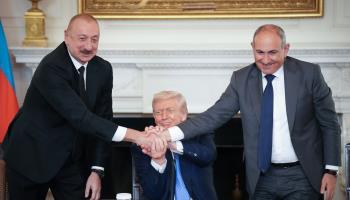Armenia and Azerbaijan signed a series of agreements in Washington, creating the conditions for a broader peace deal
On August 8, Armenian and Azerbaijani leaders signed a series of agreements in Washington DC that moved the two countries one step closer to a peace agreement. Perhaps the most notable agreement was to create the Zangezur Corridor. The route — dubbed the ‘Trump Route for International Peace and Prosperity’ (TRIPP) — will see the United States sublease management of the route to a consortium. Yerevan and Baku agreed that the corridor will be operated in accordance with Armenian law.
What’s next
Significant differences will continue to block full reconciliation. Claims by Armenia’s domestic opposition that the TRIPP will compromise its sovereignty will increase pressure on Prime Minister Nikol Pashinyan. With disputes over territories seized in recent conflicts unresolved, and with Baku insisting that Armenia change its constitution to renounce any claims on Nagorno-Karabakh, a comprehensive peace deal is unlikely to be signed soon.
Subsidiary Impacts
- Relations between Moscow and Baku will remain tense following the targeting of Azerbaijani energy facilities in Ukraine.
- Trilateral cooperation between Iran, Russia and Azerbaijan over the International North-South Transport Corridor will continue.
- Armenia will push for closer relations with China, which might result in a strategic partnership agreement with Beijing.
Analysis
Baku has long pursued the implementation of the Zangezur Corridor — a transport route just 40 kilometres in length, cutting through Armenia’s southernmost province of Syunik. It aims to connect mainland Azerbaijan with its exclave, Nakhchivan, which already enjoys developed infrastructure and transport links with Turkey.
The corridor would give Azerbaijan direct overland access to Turkey via Nakhchivan, strengthening its geopolitical position and deepening its economic integration with Ankara.
For Armenia, the project poses sovereignty and security concerns, as it involves granting passage to Azerbaijani cargo and potentially limiting control over parts of its border territory.
Key agreements in Washington
During the recent summit in Washington, the second major document initialled was the Agreement on the Establishment of Peace and Interstate Relations between Azerbaijan and Armenia. Signed by the foreign ministers, Jeyhun Bayramov and Ararat Mirzoyan, the agreement acknowledges the need for further work towards final ratification.
Both parties also agreed to dissolve the OSCE Minsk Group — a longstanding mediator in the Nagorno-Karabakh conflict. This dissolution was a core Azerbaijani demand and represents a concession from Yerevan, which had previously insisted it would only agree to such a step after the peace treaty’s formal signing.
Both countries sought to increase trade and investment ties with the United States
The summit also produced several bilateral deals. US President Donald Trump repealed Section 907 of the Freedom Support Act, a measure dating from October 1992 that prohibited US military assistance to Azerbaijan due to the first Nagorno-Karabakh war.
A memorandum of understanding was signed between Azerbaijan’s state-run oil company, SOCAR, and ExxonMobil.
Pashinyan signed separate agreements with Trump covering the Crossroads of the World project (a major Armenian connectivity initiative), cooperation in artificial intelligence (AI) and energy security.
Washington intends to sign similar agreements with Baku under a broader strategic partnership charter currently being negotiated.
Obstacles to peace
Despite the high-profile announcements, the reality remains more complex. Contrary to some Western media reports, Armenia and Azerbaijan did not sign a final peace agreement in Washington. The two remain far apart on key issues.
Azerbaijan insists that Yerevan must amend the preamble to its constitution, which indirectly references potential unification between Armenia and Nagorno-Karabakh. For Baku, removing this language is a precondition for any treaty.
Azerbaijani President Ilham Aliyev reiterated this point in Washington, stating that the documents signed there did not mean Azerbaijan had dropped this demand. He asserted that once Armenia amends its constitution to eliminate any territorial claims, the peace treaty could be signed “at any time.”
Border demarcation challenges
Another unresolved matter is the completion of border demarcation. While technical work has progressed, contentious issues remain. A major sticking point is whether Azerbaijan will withdraw from the border areas of Armenia seized during military conflicts in 2021 and 2022. The Washington agreements made no mention of troop withdrawal.
Additionally, no consensus has been reached on how border and customs control will be handled for Azerbaijani cargo passing through Armenian territory via the corridor. These unresolved matters carry the potential to spark renewed tensions between the two sides.
Iranian concerns
The potential creation of the Zangezur Corridor prompted a strong response from Iran. Ali Akbar Velayati, a senior adviser to Iran’s supreme leader, stated that the Islamic Republic would not tolerate a US presence in the corridor project. While much of this is probably posturing — as the United States will not be deploying troops to defend the route — Tehran remains uneasy.
Armenia will retain administrative control of the corridor, ensuring that Iran’s direct land connection to Armenia remains intact. Nevertheless, Iran is wary of the broader strategic consequences (see IRAN: Influence will increase in the South Caucasus – November 8, 2024).
From Tehran’s perspective, the corridor increases US and Israeli influence along its northern border and enhances Turkey’s role in the South Caucasus. It could also reduce Iranian revenue from acting as a transit route for Azerbaijani goods. Furthermore, the corridor’s completion would enable Turkey to reach the Caspian basin and Central Asia through two overland routes, further bypassing Iran.
Moscow looks on
Moscow, historically the principal power broker in Armenia-Azerbaijan relations, has emerged as another dissatisfied party. Both Yerevan and Baku have diversified their diplomatic and security partnerships, limiting their reliance on Russia (see ARMENIA: Foreign policy will shift to West – March 19, 2025 and see AZERBAIJAN: Baku forges a multi-vector foreign policy – June 27, 2024). The Washington agreements are a clear symbol of the shifting geopolitical balance in the South Caucasus (see GEORGIA: Foreign policy will shift towards Eurasia – June 13, 2024 and see PROSPECTS 2025: South Caucasus foreign policy – November 11, 2024).
Russia’s influence in the South Caucasus has diminished sharply
Russian Foreign Ministry spokesperson Maria Zakharova responded by expressing nominal support for a “zone of stability and prosperity” in the region, but emphasised that such efforts began with Russian mediation. She warned that conflicts in the South Caucasus should be settled by regional powers — specifically Turkey, Iran and Russia — and not by external actors, such as the United States. This reflects Moscow’s growing anxiety at being sidelined in a region it has long considered within its sphere of influence.
Rationale for US engagement
For Azerbaijan, the United States offers a pathway to diversify partnerships, attract Western investment, and strengthen its position vis-a-vis both Russia and Iran. The repeal of Section 907 marks a significant achievement and further signals Washington’s willingness to support Baku militarily and economically.
For Armenia, US cooperation provides an opportunity to pursue infrastructure and technology projects that could help reduce dependence on Russia, especially given Yerevan’s growing frustration with Moscow’s security guarantees (see ARMENIA: Yerevan will avoid severing ties with Russia – May 13, 2024).
Potential flashpoints
Several issues could undermine the tentative progress seen in Washington:
- Constitutional changes in Armenia are politically sensitive and could face domestic resistance.
- The absence of a clear framework for border control and customs arrangements leaves space for misinterpretation and disputes.
- Azerbaijan’s military presence on disputed border territories is likely to remain a source of friction unless addressed directly.
At the same time, Iran’s objections — while unlikely to translate into direct intervention — could complicate regional dynamics, especially if Tehran perceives the corridor as part of a broader encirclement strategy.

US President Donald Trump (C) joins hands with Azerbaijani President Ilham Aliyev (L), and Armenian Prime Minister Nikol Pashinyan (R) during a signing ceremony in the White House on August 8, 2025 (Andrew Harnik/Getty Images)
Analyst

Richard Connolly

